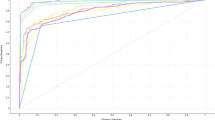Abstract
Coronary illness can be treated as one of the major causes for mortality globally. On-time and Precise conclusion on the type of disease is significant for therapy and breakdown expectancy. Research scientists are working rigorously in their respective fields to reduce the death rate. Even though lot of research took place on this area still there is a scope for increasing the prediction accuracy. The fundamental point of our proposed work is to build up a hybrid methodology using genetic algorithm (GA) with (RBF) radial basis function (GA-RBF) for the detection of coronary sickness with increased accuracy using the feature selection mechanism. The proposed system performance achieved an accuracy of 85.40% using 14 attributes, and the prediction accuracy increased to 94.20% with nine characteristics where the functionality of the proposed system performed much better after attribute reduction.









Similar content being viewed by others
References
Bui, A.L., Horwich, T.B., Fonarow, G.C.: Epidemiology and risk profile of heart failure. Nat. Rev. Cardiol. 8(1), 30–41 (2011)
Mourão-Miranda, J., Bokde, A.L.W., Born, C., Hampel, H., Stetter, M.: Classifying brain states and determining the discriminating activation patterns: support vector machine on functional MRI data. Neuroimage 28(4), 980–995 (2005)
Vanisree, K., Singaraju, J.: Decision support system for congenital heart disease diagnosis based on signs and symptoms using neural networks. Int. J. Comput. Appl. 19(6), 6–12 (2011)
Nazir, S., Shahzad, S., Septem Riza, L.: Birthmark-based software classification using rough sets. Arab. J. Sci. Eng. 42(2), 859–871 (2017)
Methaila, A., Kansal, P., Arya, H., Kumar, P.: Early heart disease prediction using data mining techniques. Proc. Comput. Sci. Inf. Technol. (CCSIT-2014) 24, 53–59 (2014)
Detrano, R., Janosi, A., Steinbrunn, W.: International application of a new probability algorithm for the diagnosis of coronary artery disease. Am. J. Cardiol. 64(5), 304–310 (1989)
Edmonds, B.: Using localized 'Gossip' to structure distributed learning. In: Proceedings of AISB symposium on socially inspired computing, pp. 1–12, Hatfield, UK (2005)
Gudadhe, M., Wankhade, K., Dongre, S.: Decision support system for heart disease based on support vector machine and artificial neural network. In: 2010 international conference on computer and communication technology, ICCCT-2010, pp 741–745 (2010). https://doi.org/10.1109/ICCCT.2010.5640377
Kahramanli, H., Allahverdi, N.: Design of a hybrid system for diabetes and heart diseases. Expert Syst. Appl. 35(1–2), 82–89 (2008)
Palaniappan S., Awang, R: Intelligent heart disease prediction system using data mining techniques. In: Proceedings of IEEE/ACS international conference on computer systems and applications (AICCSA 2008), Doha, Qatar, pp. 108–115 (2008)
Yang, G., Yinzi, R., Qing, P., Gangmin N., Gong, S., Cai, G., Zhang, Z., Li, L. Yan, L. A heart failure diagnosis model based on support vector machine. In: 2010 3rd international conference on biomedical engineering and informatics. IEEE, vol. 3, pp. 1105–1108. (2010)
The British Heart Foundation Statistics database. http://www.heartstats.org. Accessed 5 Nov 2021
https://www.montefiorenyack.org/highland/press/early-detection-of-heart-disease-can-keep-you-healthy. Accessed 8 Jan 2020
Dutta, A., Batabyal, T., Basu, M., Acton, S.T.: An efficient convolutional neural network for coronary heart disease prediction. Expert Syst. Appl. 159, 113408 (2020)
Mastanduno, M.: Data scientist: health catalyst applications of machine learning in health care (©2019 HealthCare.ai). https://healthcare.ai/what-models-has-health-catalyst-created-with-healthcare-ai/. Accessed 20 Jan 2020
Ngare, K.N.: A project proposal submitted for the study leading to a project report in partial fulfilment of the requirements for the award of a Bachelor of Science in Computer Science at St. Paul’s University. (2019)
Kanikar, P., Rajesh Kumar, D.: Prediction of cardiovascular diseases using support vector machine and Bayesian classification. Int. J. Comput. Appl. 156(2), 9–13 (2016). https://doi.org/10.5120/ijca2016912368
Saqlain, M., Hussain, W., Saqib, N.A., Khan, M.A. Identification of heart failure by using unstructured data of cardiac patients. In: Proceedings of the international conference on parallel processing workshops, pp 426–431, (2016). https://doi.org/10.1109/ICPPW.2016.66.
Manavalan, R., Saranya, S.: computational approaches for heart disease prediction—a review 2. Comput. Model-Based Heart (2018). https://doi.org/10.21917/ijsc.2018.0234
Prasad, R., Anjali, P., Adil, S., Deepa, N.: Heart disease prediction using logistic regression algorithm using machine learning. Int. J. Eng. Adv. Technol. 8(3), 659–662 (2019)
Yadav, S.M., Jadhav, S.M, Nagrale, S., Patil, N.: Application of machine learning for the detection of heart disease. In: Second international conference on innovative mechanisms for industry applications (ICIMIA 2020).
Haq, A.U., Li, J.P., Memon, M.H., Nazir, S., Sun, R.: A hybrid intelligent system framework for the prediction of heart disease using machine learning algorithms. Mob. Inf. Syst. (2018). https://doi.org/10.1155/2018/3860146
Gárate-Escamila, A.K., El Hassani, A.H., Andrès, E.: Classification models for heart disease prediction using feature selection and PCA. Inf. Med. Unlocked (2020). https://doi.org/10.1016/j.imu.2020.100330
Dua, D., Graff, C.: UCI machine learning repository [http://archive.ics.uci.edu/ml]. University of California, School of Information and Computer Science, Irvine (2019)
Peng, L., Lei, L.: A review of missing data treatment methods. Intell. Inf. Manag. Syst. Technol. 1, 412–419 (2005)
https://towardsdatascience.com/feature-selection-using-genetic-algorithms-in-r-3d9252f1aa66. Accessed 25 Oct 2020
https://www.neuraldesigner.com/blog/genetic_algorithms_for_feature_selection. Accessed 25 Oct 2020
Radial Basis Function Networks. https://www.saedsayad.com/artificial_neural_network_rbf.htm. Accessed 8 Jan 2021
Yu, H., Xie, T., Paszczynski, S., Wilamowski, B.M.: Advantages of radial basis function networks for dynamic system design. IEEE Trans. Ind. Electron. 58(12), 5438–5450 (2011)
Author information
Authors and Affiliations
Corresponding author
Rights and permissions
About this article
Cite this article
Doppala, B.P., Bhattacharyya, D., Chakkravarthy, M. et al. A hybrid machine learning approach to identify coronary diseases using feature selection mechanism on heart disease dataset. Distrib Parallel Databases 41, 1–20 (2023). https://doi.org/10.1007/s10619-021-07329-y
Accepted:
Published:
Issue Date:
DOI: https://doi.org/10.1007/s10619-021-07329-y




